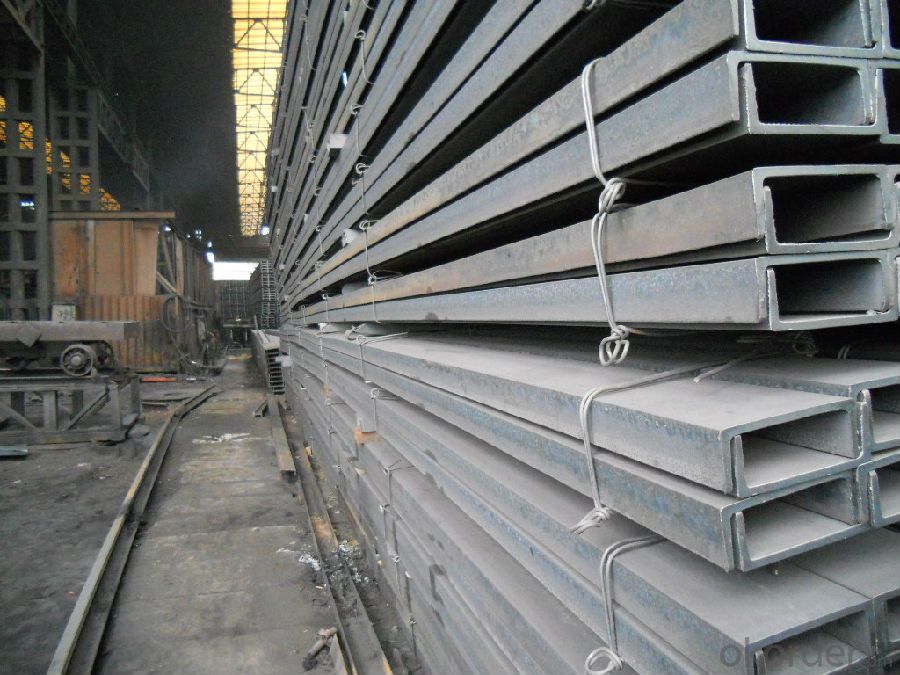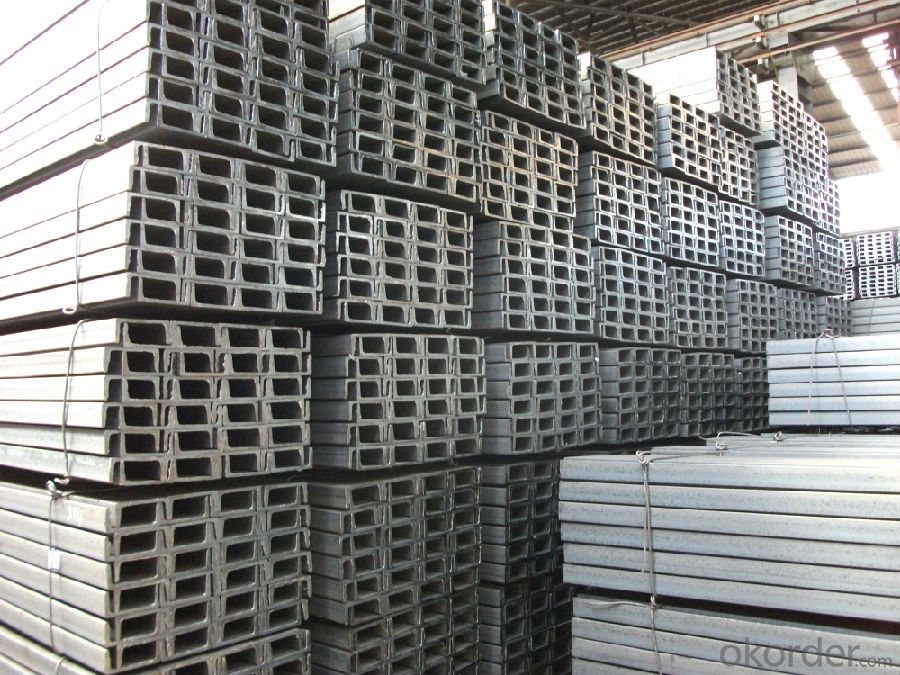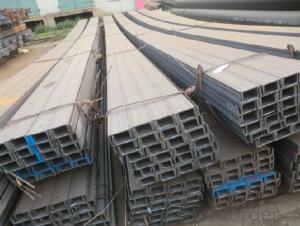Hot Rolled Steel U-Cnannel/UPN/JIS U-Channel/GB U-Channel
- Loading Port:
- Tianjin
- Payment Terms:
- TT OR LC
- Min Order Qty:
- 50 m.t.
- Supply Capability:
- 20000 m.t./month
OKorder Service Pledge
OKorder Financial Service
You Might Also Like
Item specifice
Product Description:
OKorder is offering Hot Rolled Steel U-Cnannel/UPN/JIS U-Channel/GB U-Channel at great prices with worldwide shipping. Our supplier is a world-class manufacturer of steel, with our products utilized the world over. OKorder annually supplies products to European, North American and Asian markets. We provide quotations within 24 hours of receiving an inquiry and guarantee competitive prices.
Product Applications:
Hot Rolled Steel U-Cnannel/UPN/JIS U-Channel/GB U-Channel are ideal for structural applications and are widely used in the construction of buildings and bridges, and the manufacturing, petrochemical, and transportation industries.
Product Advantages:
OKorder's Hot Rolled Steel U-Cnannel/UPN/JIS U-Channel/GB U-Channel are durable, strong, and resist corrosion.
Main Product Features:
· Premium quality
· Prompt delivery & seaworthy packing (30 days after receiving deposit)
· Corrosion resistance
· Can be recycled and reused
· Mill test certification
· Professional Service
· Competitive pricing
Product Specifications:
JIS U CHANNEL | Standard | Sectional | Dimension |
| Mass: |
| (mm) | (mm) | (mm) | (mm) |
|
50x25 | 50 | 25 | 3.0 | 6.00 | 2.37 |
75X40 | 75 | 40 | 3.8 | 7.00 | 5.30 |
75X40 | 75 | 40 | 4.0 | 7.00 | 5.60 |
75X40 | 75 | 40 | 4.5 | 7.00 | 5.85 |
75X40 | 75 | 40 | 5.0 | 7.00 | 6.92 |
|
|
|
|
|
|
100X50 | 100 | 50 | 3.8 | 6.00 | 7.30 |
100X50 | 100 | 50 | 4.2 | 6.00 | 8.03 |
100X50 | 100 | 50 | 4.5 | 7.50 | 8.97 |
100X50 | 100 | 50 | 5.0 | 7.50 | 9.36 |
|
|
|
|
|
|
125X65 | 125 | 65 | 5.2 | 6.80 | 11.66 |
125X65 | 125 | 65 | 5.3 | 6.80 | 12.17 |
125X65 | 125 | 65 | 5.5 | 8.00 | 12.91 |
125X65 | 125 | 65 | 6.0 | 8.00 | 13.40 |
|
|
|
|
|
|
150x75 | 150 | 75 | 5.5 | 7.30 | 14.66 |
150x75 | 150 | 75 | 5.7 | 10.00 | 16.71 |
150x75 | 150 | 75 | 6.0 | 10.00 | 17.90 |
150x75 | 150 | 75 | 6.5 | 10.00 | 18.60 |
150x75 | 150 | 75 | 6.5 | 10.00 | 24.00 |
|
|
|
|
|
|
200X80 | 200 | 80 | 7.5 | 11.00 | 24.60 |
Package & Delivery of JIS U Channel Steel:
1.The JIS u channel steel will be packed in bundle with steel wire at each end of every bundle and color marking in order to help the customer to recognize his goods more easily at sight.
2. And the channel steel could be loaded into 20ft or 40ft container, or by bulk cargo.If the weight of each bundle reaches more than 3.5 mt, the loading by break bulk cargo should be choosed.When the weight of each bundle reaches less than 3mt, the loading by container should be choosed.
3.As for the transportaion from mill to loading port, the truck will be usually used. And the maximum quantity for each truck is 40mt.
4.All in all, we could do in accordance with customer's request.
FAQ:
Q1: Why buy Materials & Equipment from OKorder.com?
A1: All products offered byOKorder.com are carefully selected from China's most reliable manufacturing enterprises. Through its ISO certifications, OKorder.com adheres to the highest standards and a commitment to supply chain safety and customer satisfaction.
Q2: How do we guarantee the quality of our products?
A2: We have established an advanced quality management system which conducts strict quality tests at every step, from raw materials to the final product. At the same time, we provide extensive follow-up service assurances as required.
Q3: How soon can we receive the product after purchase?
A3: Within three days of placing an order, we will begin production. The specific shipping date is dependent upon international and government factors, but is typically 7 to 10 workdays.
Q4: What makes stainless steel stainless?
A4: Stainless steel must contain at least 10.5 % chromium. It is this element that reacts with the oxygen in the air to form a complex chrome-oxide surface layer that is invisible but strong enough to prevent further oxygen from "staining" (rusting) the surface. Higher levels of chromium and the addition of other alloying elements such as nickel and molybdenum enhance this surface layer and improve the corrosion resistance of the stainless material.
Q5: Can stainless steel rust?
A5: Stainless does not "rust" as you think of regular steel rusting with a red oxide on the surface that flakes off. If you see red rust it is probably due to some iron particles that have contaminated the surface of the stainless steel and it is these iron particles that are rusting. Look at the source of the rusting and see if you can remove it from the surface.
Images:



- Q:Are steel channels suitable for railway infrastructure projects?
- Yes, steel channels are suitable for railway infrastructure projects. They offer excellent strength, durability, and load-bearing capacity, making them ideal for constructing railway tracks, bridges, and other related structures. Steel channels also possess corrosion resistance and can withstand heavy traffic and varying weather conditions, making them a reliable choice for long-lasting railway infrastructure.
- Q:Can steel channels be used for roofing applications?
- No, steel channels are not typically used for roofing applications. Roofing materials such as shingles, tiles, or metal sheets are more commonly used for this purpose.
- Q:What are the tolerance limits for steel channels?
- The tolerance limits for steel channels vary depending on the specific manufacturing standards and specifications. These limits typically include tolerances for dimensions such as width, depth, and thickness, as well as straightness and twist. It is important to refer to the relevant industry standards or consult with a manufacturer for accurate and specific tolerance limits for steel channels.
- Q:Are steel channels suitable for soundproofing?
- Typically, steel channels are unsuitable for soundproofing. Although they are commonly utilized for structural support in construction, they do not excel at blocking or absorbing sound. Steel, being dense and rigid, tends to reflect sound waves rather than absorb them. To attain effective soundproofing, it is generally recommended to employ materials with high sound absorption properties, such as acoustic foam or mass-loaded vinyl. These materials aid in reducing sound transmission and have the potential to create a more soundproof environment.
- Q:Are steel channels customizable in terms of size and shape?
- Yes, steel channels are indeed customizable in terms of size and shape. Steel channels are versatile structural components that can be modified to meet specific requirements and design needs. They can be customized in terms of length, width, depth, and even the shape of the cross-section. This flexibility allows for the creation of steel channels with various profiles, such as C-channels, U-channels, or even more complex shapes like Z-channels. Customization of steel channels enables engineers and designers to tailor the structural elements to fit specific applications, ensuring optimal performance and efficiency in various industries, including construction, manufacturing, and infrastructure.
- Q:What are the different methods of painting steel channels?
- Painting steel channels can be done using various methods, each with its own advantages and considerations. Let's explore some of these methods: 1. Brush painting: The traditional and most basic method involves using a paintbrush to directly apply paint onto the channel's surface. This technique is ideal for smaller projects or areas that require precise detailing. However, it can be time-consuming and may result in brush marks or uneven coverage. 2. Spray painting: A popular method, especially for larger projects or areas that require a smooth and even finish, is spray painting. This technique involves using a spray gun or aerosol can to create a fine mist of paint that is sprayed onto the surface. Spray painting allows for quick and efficient coverage, even in hard-to-reach areas. However, it requires proper ventilation and protective equipment to ensure safety. 3. Powder coating: For a highly durable and long-lasting finish, powder coating is an excellent choice. This method involves applying a dry powder paint that is then cured with heat to create a protective and smooth finish. Powder coating provides excellent resistance against corrosion, chemicals, and UV rays. It is commonly used in industrial applications and offers a wide range of color options. However, it requires specialized equipment and expertise, making it more suitable for professional applications. 4. Electrostatic painting: Another technique is electrostatic painting, which utilizes an electrostatic charge to attract paint particles onto the steel channel's surface. A spray gun is used to produce a charged paint mist, which is then attracted to the grounded channel. This method ensures even coverage and minimizes overspray. Electrostatic painting is commonly used when a high-quality finish and uniform coating thickness are required. 5. Dip painting: For objects with complex shapes or hard-to-reach areas, dip painting is a suitable method. This involves immersing the steel channel into a container filled with paint, allowing the paint to evenly coat the surface. Dip painting can achieve a uniform finish but requires careful control of the immersion process to prevent excess paint buildup or drips. Each method has its own advantages and considerations. The choice of painting method depends on factors such as the project size, desired finish, durability requirements, and available resources. It is crucial to consider the specific needs and constraints of the project before selecting the most suitable method for painting steel channels.
- Q:What are the different methods for reinforcing steel channels against bending?
- There are various techniques available for strengthening steel channels against bending. 1. Additional steel plates can be utilized. One approach is to affix steel plates to both the upper and lower flanges of the channel. These plates can be welded or bolted to the existing flanges, thereby enhancing their strength and rigidity. This method is commonly employed when the channel is exposed to significant bending forces or when it needs to bear heavier loads. 2. Channel stiffeners can be employed. These are extra steel components that are attached either internally or externally to the channel to augment its strength and prevent bending. Usually, these stiffeners are welded or bolted to the flanges and web of the channel. They distribute the bending forces more evenly across the channel, thereby reducing the risk of failure. 3. Concrete reinforcement is another option. This involves reinforcing the steel channel with concrete. Typically, the channel is encased in a layer of concrete, which provides added strength and stiffness. The concrete can be poured around the channel or precast and subsequently attached to it. This method is commonly utilized in construction applications, such as bridges and buildings, where the channel needs to withstand high bending forces. 4. Composite materials can also be used for reinforcement. Materials like carbon fiber reinforced polymer (CFRP) can be employed to strengthen steel channels against bending. CFRP strips or sheets can be bonded to the flanges or web of the channel, delivering additional strength and rigidity. This method is lightweight and can be easily implemented in existing structures or during fabrication. It is important to consider various factors, including the magnitude of the bending forces, the specific application, and the available resources, when selecting a reinforcement method. Consulting with a structural engineer or an industry professional is advisable to determine the most suitable approach for a particular project.
- Q:What are the different methods for protecting steel channels from UV radiation?
- There are several methods available for protecting steel channels from UV radiation. 1. Paint: One of the most common methods is to apply a UV-resistant paint coating on the surface of the steel channels. These paints contain special additives that help to reflect or absorb UV radiation, preventing it from reaching the steel and causing degradation. 2. Powder coating: Powder coating is another effective method for protecting steel channels from UV radiation. In this process, a dry powder is applied electrostatically to the surface of the steel, and then heated to form a protective coating. Powder coatings are available in a variety of colors and finishes, and many of them offer excellent UV resistance. 3. Galvanization: Galvanizing steel channels is a popular method for protecting them from UV radiation as well as other forms of corrosion. In this process, the steel is coated with a layer of zinc, which acts as a sacrificial barrier against UV rays and other environmental factors. This helps to extend the lifespan of the steel channels significantly. 4. UV-resistant coatings: There are specialized UV-resistant coatings available in the market specifically designed for protecting steel from UV radiation. These coatings are typically applied as a liquid and form a thin, transparent layer on the surface of the steel. They provide excellent UV protection while maintaining the appearance of the steel channels. 5. Protective films: Another method for protecting steel channels from UV radiation is by using protective films or tapes. These films are applied directly to the surface of the steel and act as a barrier against UV rays. They are easy to install and remove, making them a cost-effective solution for temporary protection. It is important to choose the most appropriate method based on the specific application and requirements. Factors such as the level of UV exposure, desired lifespan, and aesthetic considerations should be taken into account when selecting a method for protecting steel channels from UV radiation.
- Q:Overhanging Scaffold; channel spacing
- The longitudinal horizontal rod shall be on the inside of the vertical pole, and its length shall not be less than 3 spans. Longitudinal butt joints should be staggered, two adjacent longitudinal joints should not be set in a synchronous or within the same span, not synchronous or different across the two adjacent joints staggered horizontal distance should not be less than 500mm, each jointcenter distance from the primary node is no larger than the vertical distance of 1/3. A bar two segment height should not exceed 2cm, the horizontal bar full Changping flatness can not exceed the total length of the scaffold of 1/300, and is no more than 10m.
- Q:What are the different fabrication methods for steel channels?
- Steel channels can be fabricated using different methods depending on the desired outcomes and requirements. These methods include hot rolling, cold rolling, press braking, and welding. The most commonly used method for fabricating steel channels is hot rolling. It involves heating the steel billet or ingot to a high temperature and passing it through rollers to shape it into the desired channel profile. Hot rolling is efficient and cost-effective, allowing for a wide range of sizes and shapes to be produced. Another method is cold rolling, which involves passing the steel through rollers at room temperature. This process produces channels with precise dimensions and improved surface finish. Cold rolling is ideal for channels with tighter tolerances and smoother surfaces. Press braking is a method that bends a flat steel plate into a channel shape using a press brake machine. It is suitable for custom or non-standard channel shapes where hot or cold rolling may not be appropriate. Welding is a method used to join steel pieces together to form a channel. It is commonly used for complex shapes or modifications to existing channels. Welding techniques such as MIG, TIG, or arc welding can be employed. The choice of fabrication method depends on factors like channel dimensions, tolerances, surface finish, and shape complexity. Each method has its advantages and limitations, so it is important to select the most suitable one for the project's specific requirements.
1. Manufacturer Overview |
|
|---|---|
| Location | |
| Year Established | |
| Annual Output Value | |
| Main Markets | |
| Company Certifications | |
2. Manufacturer Certificates |
|
|---|---|
| a) Certification Name | |
| Range | |
| Reference | |
| Validity Period | |
3. Manufacturer Capability |
|
|---|---|
| a)Trade Capacity | |
| Nearest Port | |
| Export Percentage | |
| No.of Employees in Trade Department | |
| Language Spoken: | |
| b)Factory Information | |
| Factory Size: | |
| No. of Production Lines | |
| Contract Manufacturing | |
| Product Price Range | |
Send your message to us
Hot Rolled Steel U-Cnannel/UPN/JIS U-Channel/GB U-Channel
- Loading Port:
- Tianjin
- Payment Terms:
- TT OR LC
- Min Order Qty:
- 50 m.t.
- Supply Capability:
- 20000 m.t./month
OKorder Service Pledge
OKorder Financial Service
Similar products
New products
Hot products
Related keywords





























